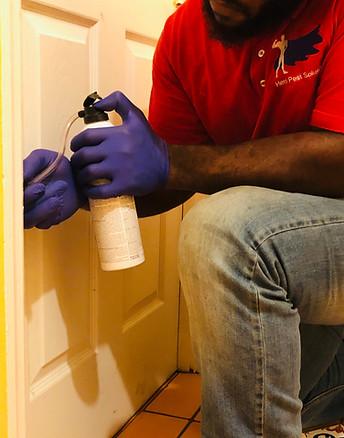Termites

Termites are (unfortunately) a very common pest in the US, and South Florida is no exception. Our weather creates the perfect environment for them to thrive. Since the temperature rarely dips below freezing, termites can live, eat, and swarm comfortably year-round. And our wet weather keeps the wood moist and soft for easy feeding, no matter what season it is.
Termites feed on wood, and since our homes are primarily made of wood, they are easily the most destructive pest in the world. Some termites eat only hard, healthy wood. Some termites only eat soft, wet wood. Some termites live in the wood they feed on, while others live in the soil under your home. Knowing what type of termite you may have is very important, as the treatment options for each vary greatly.
Different Types of Termites
There are two basic families (types) of termites that will destroy your home: subterranean and drywood termites. They are named for where they nest (subterranean = underground in the soil, drywood = in dry wood). Both of these termites' diets consist of wood. Both have a specific swarming season. They even look similar. But they differ in many ways as well.
Differences in Appearance
Pictured below are 3 termites that are most common in south Florida. 2 are subterranean and the other is a drywood termite. The class pictured is the swarmer (the winged class). This class is the easiest to identify their differences.
Subterranean
Drywood



Eastern Sub
Formosan Sub
Drywood
Wings
White with a noticeable outline around the entire wing
Yellow with a noticeable outline around the entire wing
Rainbow colored with 1 vein along outside of wing
Body
Black
Brown
Brown
Not seeing your termite? You may have ants! Check out the differences here
Differences in Nesting and Swarming

Drywood Termites target dry, healthy wood to nest in. In most homes, the biggest collections of dry wood is in our attics. They can also target window and door frames, doors, hardwood floors, cabinets, and baseboards. They usually swarm in spring-summer during the day.
Subterranean Termites target wet, damaged wood to nest in. If the wood isn't moist, they can bring moisture from the soil via mud tubes. They usually swarm spring-summer
after a heavy rain in the late
afternoon.
Differences in Damage and Droppings
Drywood Termite droppings, or frass, look like piles of sawdust, and can be any shade of brown, from beige, reddish-brown, dark brown, and even black.
They are actually little balls of wood and fall out of the wood as the termite exits the wood through a kick-out hole.

Tent Alterative Termite Control Hero Pest Solutions

Tent Alterative Termite Control Hero Pest Solutions

Tent Alterative Termite Control Hero Pest Solutions

Tent Alterative Termite Control Hero Pest Solutions
Their damage resembles hollowed-out wood that may be cracked through by applying pressure. Usually, a significant amount of droppings fall from damaged wood.

No Tent Termite Treatment Hero Pest Solutions

No Tent Termite Treatment Hero Pest Solutions

No Tent Termite Treatment Hero Pest Solutions

No Tent Termite Treatment Hero Pest Solutions

No Tent Termite Treatment Hero Pest Solutions

No Tent Termite Treatment Hero Pest Solutions

No Tent Termite Treatment Hero Pest Solutions

No Tent Termite Treatment Hero Pest Solutions
Subterranean Termite droppings resemble mud or water damage. Sometimes, a mud tube can be found going from the ground to the wood they are feeding on.
Mud tubes serve as a protected highway to transfer moist soil to their food source and carry the wood back to the nest.

No Tent Termite Treatment Hero Pest Solutions

No Tent Termite Treatment Hero Pest Solutions

No Tent Termite Treatment Hero Pest Solutions

No Tent Termite Treatment Hero Pest Solutions
Their damage resembles water-damaged wood. Upon inspection, the wood can look as if it has been shredded, with mud throughout the wood.
Differences in Treatment Methods
Every effective termite treatment is determined by targeting where the specific termite is nesting.
Drywood termites live in the dry wood they feed on, so treatment would focus on that wood (attic, studs, baseboards, doors, etc.).
Common treatment for these termites includes tenting, liquid, and spot treating.
Subterranean termites live underground in the soil, carrying their food from the source to colony underground. Treatment would focus on the soil around and under the structure's foundation.
Common treatments for these termites include trenching, soil saturation, baiting, drilling, and injections.


If you are interested in our termite services, or would like more information, feel free contact us by clicking here.
